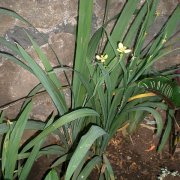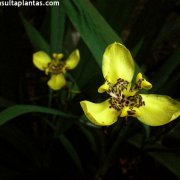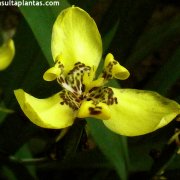Care of the rhizomatous plant Neomarica longifolia or Yellow Walking Iris |
|
The genus Neomarica, family Iridaceae, comprises 16 species of rhizomatous plants native to Mexico and Central and South America. Some species are: Neomarica longifolia, Neomarica gracilis, Neomarica northiana, Neomarica caerulea, Neomarica variegata, Neomarica nitida. Common names: Yellow Walking Iris, Apostle Plant, Martinique trimezia. This species is native to South Mexico and South America. They are perennial rhizomatous plants that reach 50 cm (19.68") in height. The sword-shaped leaves closely resemble those of the genus Iris. The showy yellow flowers have brown spots in the center and only last one day but produce more the next day. They can bloom throughout the year, especially in spring and fall. This tropical plant is used in shady areas of the garden (under trees, for example), next to ponds, in pots for terraces and as a houseplant and greenhouse. Yellow Walking Iris can also be grown in aquariums or in hanging baskets. Neomarica longifolia grows in semi-shade and shade exposures. It needs a warm climate because it does not resist the cold below 10 ºC (50 ºF). The soil can be a mixture of garden substrate with 22% organic matter and 20% coarse sand. Planting or transplanting is done in early spring. It should be watered frequently so that the soil is always moist, although Martinique trimezia resists drought quite well. Fertilize every 20 days with special mineral fertilizer for flowering in spring and autumn. Neomarica longifolia is a plant prone to attack by snails and slugs. Yellow Walking Iris is propagated from seedlings that produce flower stems (only if grown in garden soil) or by rhizome division. |
Images of the rhizomatous plant Neomarica longifolia or Yellow Walking Iris |
Find plants
Neomarica longifolia or Yellow Walking Iris | Care and Growing
© 2026 FavThemes


